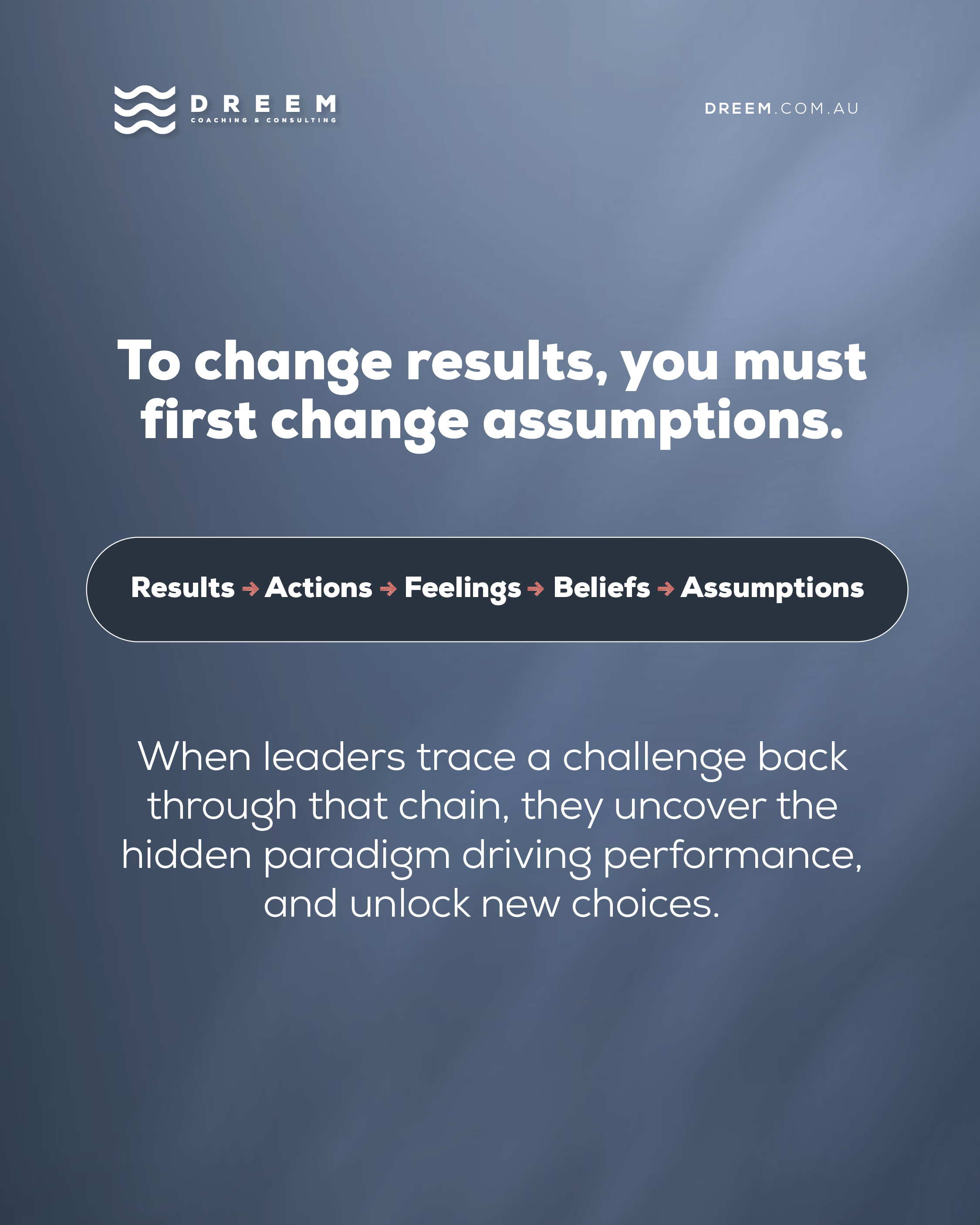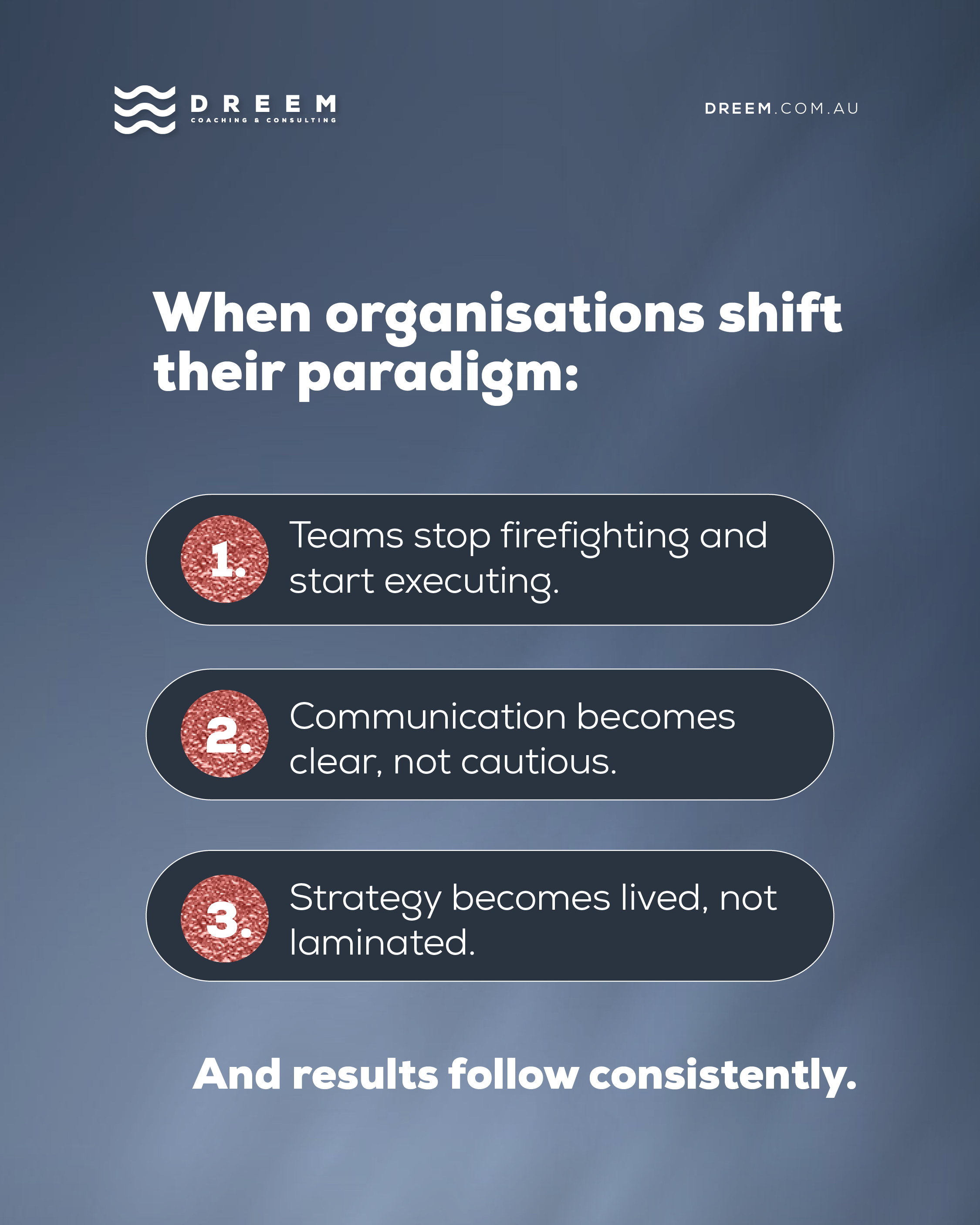
How to Build a High-Performing Team: Leadership, Operating Rhythm, and Organisational Alignment
Being the Maestro of Your High-Performing Team
Building a high-performing team can feel overwhelming or out of your control. Many leaders intellectually understand what great leadership should look like, yet struggle to translate theory into results inside their organisation.
Leadership has also become a public “spectator sport.” With endless commentary online, it’s easier than ever to criticise from the sidelines and far harder to lead with clarity, courage, and consistency.
But building a high-performing team is not about popularity, perfection, or theory.
It’s about alignment, execution, and the operating rhythm that holds everything together.
In many of the previous articles that I have shared, I discuss the importance of goal setting, working from the end in mind perspective, setting strategy and mindset.
In our work with organisations, Dreem focuses on five core pillars:
The 5 Pillars of Organisational Performance
-
Leadership
-
Sales
-
Marketing
-
Finance
-
Mindset – This part is the foundation for all pillars. Success is hugely dependent on mindset, and while strategy is critical, we now know that strategy plays a secondary role to mindset in the success equation.
These five pillars are intertwined, and nothing is mutually exclusive. It’s a continuous cycle.
The Essential Components of Leadership Alignment
Within the leadership framework, where it all starts, there are critical elements that need to be created and established throughout the entire organisation. These elements include:
- The organisational Goal, leading to the departmental goals, then the individual goal.
- The organisational Values.
- The organisational Culture.
- The organisational Coaching Framework.
- The organisational overall Alignment.
- The organisational Structure at the Goal achieved
- Creating the concept and framework of Self Leadership throughout the organisation
- The organisational Leadership Models have been established.
- The organisational Gap Analysis. Where you are now, compared to where you want to get to.
Once established, and please note there is detail in each of the above points, a very critical element needs to be introduced.
The Operating Rhythm: The Beat That Drives High Performance
The Execution framework, the accountability and support piece. In other words, the Operating Rhythm. You really can liken this to the Maestro and their Orchestra.
Many organisations have great strategies and plans, yet it’s in the execution that they can all fall apart. Breaking it all down to its lowest common denominator is where the great work can come unstuck, whether you are a small or large team, or even a single operator.
We have this expectation that once we have the goal, everyone should just be on the same page and forget that as a leader (the maestro), the most critical part is to disseminate all this information, break it down and execute it with seamless precision (The beat), which will eventually produce the beautiful piece of work called the music….
Developing the right operating rhythm for your organisation becomes the number one priority and will help you work out:
- How to keep everyone aligned, focused, accountable, and motivated.
- How to find the optimal rhythm of your team.
- It creates the gift of time for organisations, allowing for the right thinking by all team members.
- How an operating rhythm can eliminate noise, get everyone off the much-dreaded hamster wheel, and help team members become emotionally involved with your company's goals.
Defining the organisational and team’s Operating Rhythm?
According to www.whatissixsigma.net the “Operating Rhythm can be defined as a set of predefined processes of communication and interactions that should be present between different departments, to ensure that the flow of operations is not interrupted and is controlled as intended. It provides a structured way of communication through which the stakeholders communicate with the project team/operations, and vice versa, on items like roles, milestones, outcomes, targets, and so on that are aligned to the organisation’s vision.”
As mentioned, the importance of an operating rhythm is critical for success regardless of the size of the organisation, department, or team. Much like an orchestra, setting in place the right processes and systems with the idea of helping every team member stay connected and aligned to the overall goal is critical.
Once this is established, and everyone is on the same page, training, coaching, and any form of team and individual support will have a much bigger impact on overall performance and results, as well as satisfaction and a sense of belonging. It creates that much-needed harmony. This is the “How” that many organisations fail to see or don’t put enough emphasis on.
Why Strategy Fails: The Missing Link Between “Why” and “How”
Humans operate on autopilot 96–98% of the time. Without clear goals and conscious habits, organisations default to “how we’ve always done it.”
How often do we see this in organisations or even in our own day-to-day lives? As an example, if you ask people/departments in organisations why they continue to generate reports monthly, who looks at the reports, and what value do they provide? Many people will not be able to answer the questions beyond, “This is how we have always done it.”
So, if we naturally create habits anyway in our daily lives and in organisations, why not create ones that will habitualise high performance? We do have choices. We can either allow habits to be created unconsciously or create the ones that will help us achieve greater results with meaningful growth. This is how you create Balance, Focus and Flow in your business.
Imagine how powerful it would be if you could automate the quest for excellence by introducing the operating rhythm that best suits your organisation.
This would mean you are introducing both effectiveness as well as efficiency into your business, where every meeting has a purpose, and you create a cycle of actioning agreed-upon tasks and delivery of results that stick.
Each team member is in the right meeting, at the right time, with the right information, as well as support, to be able to deliver on what is agreed to in the right time frame.
This quote sums it all up beautifully:
“As a leader, you must consistently drive effective communication. Meetings must be intentional. Your organisational rhythm should value purpose over habit, and effectiveness over efficiency. Just to pick up on these two points, purpose over habit. If you are looking at your operating rhythm and it is just the rigmarole of every single week and you’re going through the motions, it’s time to change it up. Your operating rhythm, the purpose of it is to drive growth, focus, and unity as a group. If it’s not doing that, then you need to change it up. Purpose over habit. Habit, if it’s a bad habit, is not one you want.” – Chris Fussell, President of McChrystal Group
The Five Levels of Operating Rhythm Meetings
The key is to make sure that you have the right mix of meetings for your operating rhythm to run like a well-oiled machine.
The simple structure of the meeting's top line looks like this:
-
Annual strategic offsite meeting - 1 or 2 days
This is when you come together with your team every single year to develop and refine your why or purpose, your vision, your values, your strategy, tactical priorities, and goals that you are going to hit for the year ahead. Once you have your 5 to 10-year goal, it’s time to decide what your gaps are and your priorities for the next 12 months.
This is a one-to-two-day off-site meeting. It’s highly recommended to have a facilitator for these meetings. You can add team building and any other professional development to the mix during this time. Remove yourself from the office and head into the mountains, the countryside, or the beach, for example. Get away from it all with your team.
This provides an opportunity for clear thinking with no noise. Never underestimate the power of taking your team away from it all, away from the office for one or two days a year. This is a high priority, one of the highest priorities for the year. During this time, a specific facilitator's guide is produced to ensure you reach all your meeting goals.
-
Quarterly Alignment Meetings (½–1 day)
If your annual meeting is a two-day offsite, your quarterly meetings will be a half-day to one day. It’s recommended to make your first quarterly meeting also a part of your annual offsite. The 2nd quarter meeting may be half a day, and then at the 6-month mark, you make it a one-day event.
For the third quarter, create another half-day meeting. Your quarterly meetings are all about making sure you’re on track strategically and setting the priorities and tactical plan for the next quarter. It’s a reconnection to your vision, purpose, and strategy refinement, dealing with any major issues or changes, and making new decisions where needed. During this time, a specific facilitator's guide is also produced to ensure you reach all your meeting goals.
-
Monthly Execution Meetings (2–3 hours)
Your monthly meeting allows everyone to report on your initiatives and tactical projects that you are running to execute the strategy. In other words, now you are starting to move from strategy down to tactics in your discussions. This is how you get to your goal. This allows you to do the small things in big ways, rather than constantly being stuck in doing big things in very small ways.
This is the execution piece and the steps you’re going to take along the way. You get together once a month with full transparency, where each person/dept can report on time, budget, resources needed, actions, barriers, and challenges, as well as risks for each of the tactical initiatives with solutions to help improve overall team performance.
-
Weekly Alignment Meetings (30–60 minutes)
Weekly meetings, preferably on a Monday morning, by team and then reporting upwards to the leadership, team weekly meetings are essential. You can discuss operational improvements, as well as key issues of risks in prioritised activities. You bring your team together to solve things quickly, to ensure no initiative is stalled or put in the ´too hard basket´. This can be done by department and then by the leadership team. The main questions for conversation to include are:
- What are you focusing on?
- What did you accomplish last week?
- What barriers did you face?
- How can I/we help you remove those barriers?
- When can we expect deliverables by?
- Document for accountability – Rinse and repeat.
-
Daily Huddles (10–15 minutes)
The daily huddle is very operational and yet so critical. But this would be a daily stand-up – 10 to 15 minutes long maximum, with exception reporting only. You won’t be reporting everything that’s happening in your team, just the things that people need to know about, and the three things each person is focusing on for the day. The intention is to keep everyone focused, removing barriers that may get in the way and eliminating unnecessary meetings and issues that arise from a lack of alignment and uncertainty in your team.
The questions are repetitive every day and designed to remove barriers standing in the way, including our own self-limiting barriers.
- What are you focusing on?
- What did you accomplish yesterday?
- What barriers did you face?
- How can I help you remove those barriers?
- Document – Rinse and repeat.
This is not a session to play blame games or test people. It is genuinely to help everyone understand what the other is working on and to help remove obstacles that may hinder delivery. It allows you to understand what is happening in your team with little unwanted surprises popping up, as you have full transparency. It’s very tactical by nature, yet so powerful. Constant spaced repetition is the key to developing the right habits and ensuring you get results that stick again.
The Gift of Time, Focus, and Performance
Introducing this Operating Rhythm into your business is the ultimate gift of time.
At first, leaders often resist introducing a new operating rhythm. It feels like “another thing to do.”
But once embedded, it becomes the ultimate time creator—cutting unnecessary meetings, reducing rework, and replacing confusion with clarity.
It strengthens:
- Motivation
- Collaboration
- Accountability
- Belonging
- Performance
When people have clarity, structure, and support, the organisation moves together—like a high-performing orchestra.

Ready to Build Your High-Performing Team?
If you’d like support designing your organisation’s operating rhythm, strengthening leadership capability, or improving alignment across your team, we can help.
- Operating Rhythm Design
- High-Performing Team Training Workshops
- Leadership Development Programs
- Organisational Alignment Consulting
Connect with us using the form below or email [email protected] to begin.
Connect directly with us
We hate SPAM. We will never sell your information, for any reason.



